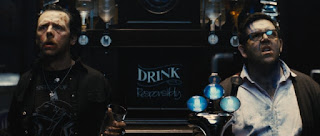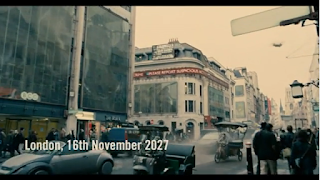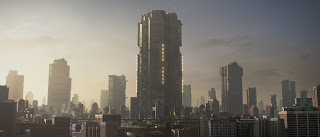Edgar Wright is by far one of my favourite filmmakers of the modern era. Over his (as of yet) small filmography, the director has already managed to create his own unique film making style and displays an all round love an appreciation for cinema itself. With films such as Scott Pilgrim vs The World and this years Baby Driver, the British director has managed to become recognised on an international level. However, arguably his best works are the films that make up his three coloured cornetto trilogy. The first film, Shaun of the Dead saw a group of survivors navigating through a zombie ridden suburban London. The second entry, Hot Fuzz, saw a newly arrived police sergeant investigating a series of grizzly murders in a small rural village. Finally, The World's End follows five old school friends who embark on an apocalyptic pub crawl through their old hometown. The films are all unrelated, being tied together only by recurring cast members and the inclusion of cornetto's.
I was extremely excited for the release of The World's End in 2013, being a big fan of both its predecessors and Wright's style in general. However, when I finally did watch it I didn't quite enjoy it as I thought I would. Maybe it was the greater reliance on CGI in comparison to the previous two films, or maybe it was simply because nothing could ever top Hot Fuzz, but when I first watched it I wasn't quite feeling The World's End. However, recently my girlfriend convinced me to re-watch it and I decided to give it another chance. Oh how wrong I was the first time around. After revisiting The World's End again, I absolutely loved it. Not only is it just as hilarious as it's fellow cornetto films, but it's packed full of little references and details that Wright is so masterful at slipping in. So now, I'm going to take the time to run through some of the films finest qualities and easter eggs that I somehow missed the first time round. Obvious SPOILERS ahead if you haven't seen the film.
The Most Epic Pints Ever Pulled
One of the best things about any Edgar Wright film is the editing, it's quick, snappy, and adds a subtle layer of intensity to simple transitions. In The World's End, the effect of the editing is best felt during the first scene in which the lads order a pint. Upon arriving at The First Post, the first pub along the Golden Mile pub crawl, ringleader Gary King (Simon Pegg) orders five pints for the five lads, only for Andy (Nick Frost) to cut in and inform Gary that he'd much rather a water. Gary's sheer outrage at this is truly felt as we cut to a montage of pints being poured. Wright cuts between the bottom of the pint glass quickly filling up with beer, and the tap itself, slowly zooming in on the latter between every cut. The sound of the beer gushing into the pint glass, the quick cutting, and the overall sound design make this simple action an incredibly intense one, enough to make your heart race. Then, as we get to Andy's glass of water, the tension is cut we get a simple shot of a glass of water being poured. It's a minor detail, but I felt it was a clever way for Wright bring that scene to life. He could have easily just cut from Andy ordering his water to the lads sipping on their pints, in any ordinary film the simple action of pulling a pint is a rather mundane one. However, Wright makes it an incredibly intense moment, emphasising the importance of these first pints to our protagonists, and the significance of Andy's water that is expanded upon later. They really are the most epic pints ever poured.
Premonitory Pubs
One of the films best, and most obvious details that I kick myself for not picking up on first time around, is how the names of each pub reflect the events that follow in each one. There are twelve pubs along the Golden Mile that the gang visit throughout, the first one naturally being called The First Post. The second pub which is identical to the First Post is cleverly named The Old Familiar, while the third pub, the place where Gary King is finally recognised, is called The Famous Cock. The 'Cock' part comes from the fact that the only reason Gary was recognised was because he had been barred years prior. The fourth pub aptly named The Cross Hands is where the gang work together in a fight against the blanks, and the fifth pub, The Good Companion, has a sign that displays four sad faces and a happy one while inside, Gary is the only one of his friends not acting happy. They meet their former drug dealer Reverand Green (Micheal Smiley) in The Trusted Servant, and a pair of unsavory twins in The Two Headed Dog. Things get more intense at The Mermaid where the characters are almost seduced to their deaths, and afterwards, they face off against swarms of blanks at The Bee Hive. In the final stretch, Gary King opts to continue the pub crawl alone at The Kings Head (the King on the sign even resembles Simon Pegg), before crashing through the wall at The Hole in The Wall, and finally arriving at The World's End where.. well, you can gather what happens there. It's one of the many clever details that Wright sneaks into the film and by far my favourite of them all.
Easter Eggs Galore
As I've mentioned, the film is stuffed with numerous easter eggs and little details throughout. First of all, the film contains a lot of allusions to the Medieval era, the most obvious being the characters surnames that all represent figures from Medieval society. Gary King, Andy Knightly, Oliver Chamberlain (Martin freeman), Steven Prince (Paddy Considine), and Peter Page (Eddie Marsan) all reference figures from society in the Middle Ages. This reflects the whole idea of the gangs 'quest' along the Golden Mile and is fully embraced in the films final moments where the post-apocalyptic Earth has come to resemble a Medieval landscape.
Other references include Gary's mentioning of Alexander Dumas' The Three Musketeers, which comes into play significantly towards the end, and a scene that is visually reminiscent of an old giallo film of which Wright is a confessed fan. I'm sure that there are a lot more that I could pick up on another viewing, Wright manages to add layers upon layers of little detailed references throughout that it's so hard to keep track of them all.
The King and his Knight
In both Shaun of the Dead and Hot Fuzz, Simon Pegg and Nick Frost play rather similar roles. Pegg is generally the more sensible and serious one, while Frost usually plays the incompetent sidekick. However, in this film the roes were somewhat switched with Pegg playing the cocky and arrogant Gary King, and Frost playing the sensible and serious Andy Knightly. It was interesting to see the duo essentially swap roles and play characters who were drastically different to their previous ones of the cornetto trilogy. It gave them a chance to further display their acting capabilities by providing new characters to play around with.
Along with this, out of all the duos Pegg and Frost have played, Andy and Gary are by far the most tragic. While Gary King has a calm and cool exterior, it is revealed later in the film that since leaving school he has attempted suicide and become an alcoholic. The reason why he was so obsessed with reuniting his school pals and finishing the Golden Mile was because his life was practically empty without them, and seeing them again would provide him with some sort of meaning. You can't help but feel sorry for Gary King, but by the end it appears that he is one of the few who have benefited from the worlds end. Andy has had a similarly tragic life, finding himself in jail for a year after driving while intoxicated in an attempt to get an overdosed Gary to the hospital many years ago. This explains his initial resentment towards Gary and reluctance to take part in the pub crawl. Both Gary and Andy become very multi-layered characters by the end, two men fed up with the way their lives turn out. However, in a sort of bittersweet ending, we finally see them finding solace in the apocalypse with their lives improving significantly because of it.
A Soundtrack For The Ages
Like all of Wright's films, The World's End has a quality soundtrack to accompany it. Apologies to Baby Driver but I dare say that this is Wright's best soundtrack of his entire career. From The Happy Mondays' 'Step On', to Blur's 'There's No Other Way', and even The Doors' 'Alabama Song' which is extremely appropriate for the films subject matter. The soundtrack combines a number of songs from a variety of genres and eras that blend together to create the perfect playlist for the ultimate pub crawl. Tunes and Pints all round.
It's clear to me now that I had severely misjudged The World's End when it first came out four years ago. Maybe I hadn't been paying enough attention at the time, maybe I was expecting something more akin to Hot Fuzz, but it no longer matters as I have a newly found love for this film. From Wright's signature sense of humor, to the various easter eggs, to the tragic heroes of the piece, The World's End is a fine film and one of Wright's best works to date. It's a film that needs to be watched multiple times in order to truly appreciate it and pick up on every detail, and I know for a fact that I will be watching it again very soon.




















